The verification table (also referred to as compliance matrix) is an overview that contains all the model’s verification data (i.e. verification phases, methods, outcomes, demonstration documents, assessments) in a tabular form.
The verification table can be found under the verification heading in the main navigation bar.

On the verification table page, you can either choose a predefined table definition (earlier created by either yourself or another project participant) or create a new table definition.


In this article, we’ll focus on how you can create a new table definition and the different options for data selection.
Creating a new table definition
As said above, you must click on the button New to create a new table definition. By doing so, you will be presented with various selection possibilities for the requirements you wish to include in your table.
- Verification data (e.g. for selecting a particular verification phase or outcome)
- Requirements data (e.g. for selecting a particular requirements tree or requirement subject)

Below, we will explain each of the possible selections.
Verification selections
There are various selection possibilities to get to the verifications that you are interested in:
Phase
Verifications can take place in different phases (e.g concept design, detail design, execution, …). You use this selection to select the phase that is relevant for you (NB verification phases can be added via the verification settings menu)
Verification plan
The term verification plan refers to specifications concerning how, when and by whom a verification has to be done. Selecting present will give you all the requirements that have to be verified.
Responsible
Verifications can be assigned to different persons, roles or organizations. Use this selection to see the verifications that are assigned to a particular person, role or organization.
Outcome
Verifications obviously have outcomes, such as ‘compliant’ or ‘non-compliant’ (depending on how you have defined these). Use this selection to find verifications with a particular outcome or verifications that lack an outcome (which means that they still have to be done).
Assessment (if this module has been activated)
Verification assessments are reviews or evaluations of the verification outcomes, e.g. by the project’s quality manager or systems engineer, to ensure that they are valid and correct. You can use this selection to find verification outcomes that have been accepted or rejected, or outcomes that are still lacking an assessment [Empty].
Demonstration documents
This selection can be used to view all the verifications that are linked to a specific demonstration document.
Requirement selections
You can use the requirement selections to select particular sets of requirements, e.g. all system requirements or all process requirements. The selection possibilities are:
Tree(part)
Use this selection to select a particular tree (e.g. spaces tree or systems & elements tree). In addition, you can use the Select tree part button to select a particular part of the selected tree (e.g. particular part of the building or a particular type of systems).
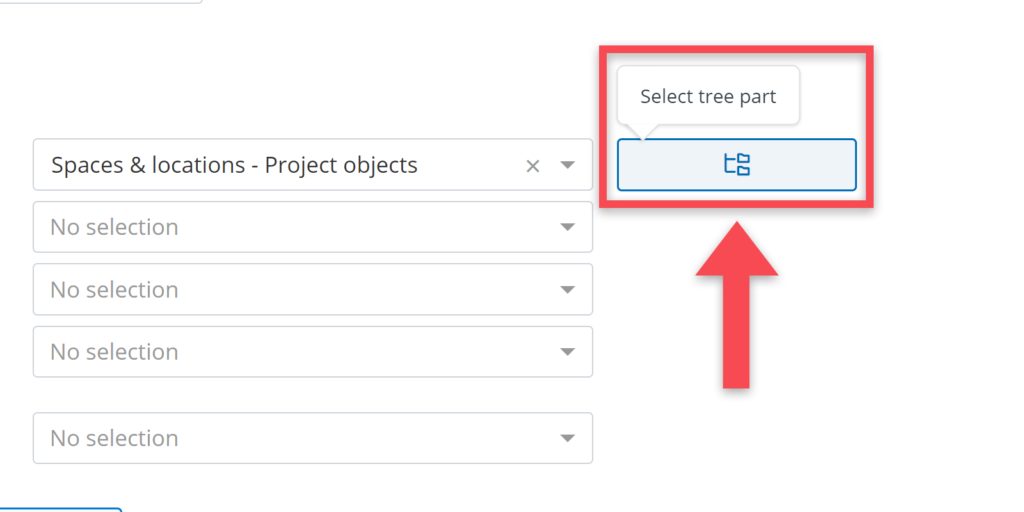
Object type
Trees can contain different types of objects (e.g. building, group of spaces, spaces, outdoor spaces, …). Use this selection to focus on one particular type of object.
Label
Objects may be ‘tagged’ with labels. Use this filter if you only want to see objects with a particular label.
Instance of
This selection is only available when you have selected the tree Spaces & locations – project objects and when working with typicals. It allows you to select spaces or segments that are the instances of a particular typical object (e.g. meeting room or toilet space).
Requirement subject
With this selection you can refine your search results by choosing a specific requirement subject. For example, for the spaces tree, you can find requirement types like visual or acoustic comfort.
Viewing and saving your table definition
Once you have made your selections, you can click on the Show button to get to the table.

If you expect that you will need to use this table set-up more than once, then save it by clicking on the Save table definition button.

More explanation about saving table definitions can be found here.
Table columns
In the table itself, you will see quite a number of columns. These columns are grouped in the following way:
- Requirement (what needs to be verified)?
- RFC (possible change requests concerning a requirement)
- Phase (when does a requirement need to be verified?)
- Verification plan (how and by whom should the verification be executed?)
- Verification result (what is the outcome of the verification?)
- Verification assessment (have the verification results been accepted or rejected?)
All five are discussed below.

Requirements
The first group of columns displays information about the requirements that will be (or have been) verified.
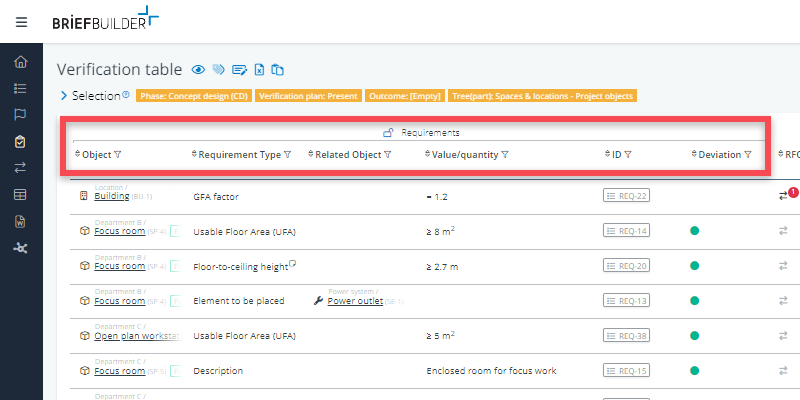
Object
This is the object to which a requirement belongs. Filtering in this column is very useful when looking for the requirements of a particular system or element (e.g. the HVAC system)
Requirement type
This column shows what type of requirement it concerns. Filtering in this column is very useful when you want to link verification information to a particular type of standard property (e.g. floor heights) or a particular type of relation (e.g. adjacency relations).
Related object
This column shows objects that are related to the objects in the first column. For example power sockets that need to be placed in rooms, or the interface relations between different systems.
Value/quantity
This concerns the value or quantity of a requirement (e.g. 20 m2 or 4 items in the case of power sockets).
ID
The unique identifier of a requirement.
Deviation (only relevant when working with typicals)
An indication whether a requirement is deviating from a typical’s requirement or not. This column is useful when you want to focus on deviations in your verification plan.
RFC
RFC stands for request-for-change. This column can be used to view and create RFC’s. This can be relevant when a verification activity indicates that a requirement isn’t smart or feasible and should be changed.
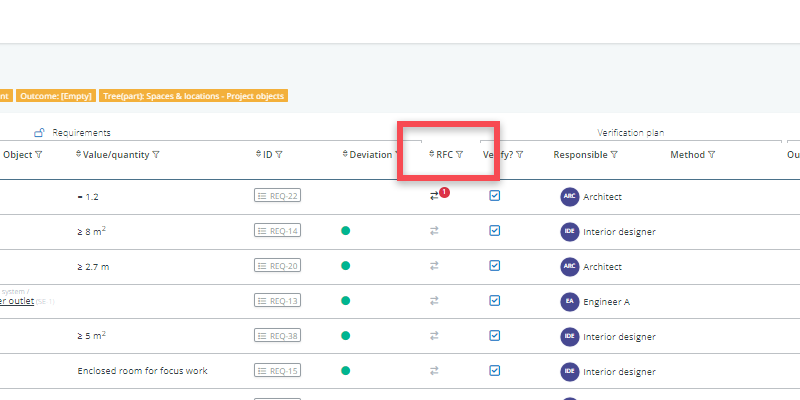
Phase
The Phase part shows the relevant verification phase. Note: this column is only shown when you have selected multiple phases in the selection window.
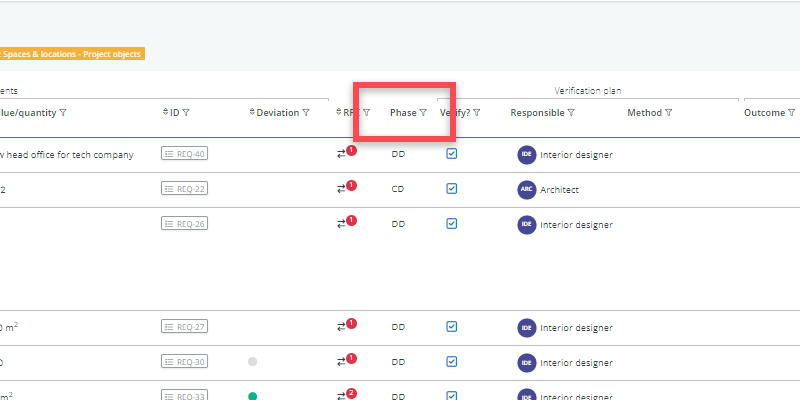
Verification plan
Next to the phase column the verification plan is displayed. This part of the table is used to set up the verification plan. It features the following two columns:
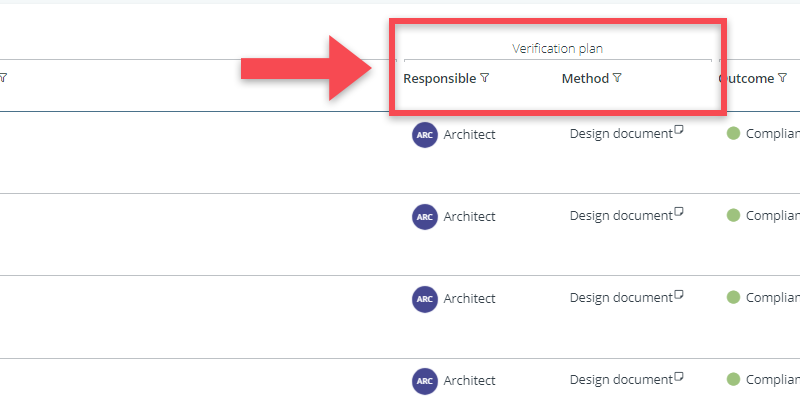
Verify?
This first column features check boxes that are linked to the ‘Phase’ column. By checking a box, you determine if the requirement should be verified in that specific phase.
Responsible
In this can select and see who is responsible for the execution of the verification.
In addition to these two, there may be other columns (e.g. method), but that depends on the model’s verification settings.
Verification result
This part of the table shows information related to the outcome of the verification.
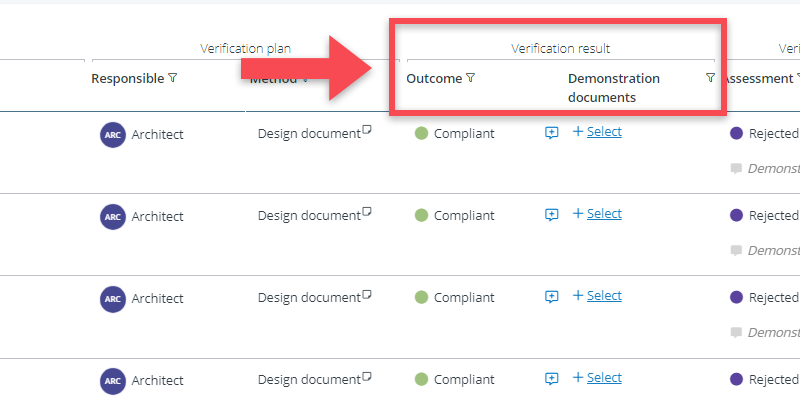
This part contains at least two columns:
Outcome
The Outcome column displays the outcome of the executed verification, this can be something like Not compliant or Compliant. The options in the dropdown menu are also customizable and are set up in the verification settings.
Demonstration document
The Demonstration document columns gives you the option to select a demonstration document to demonstrate that solutions are compliant with the client’s requirements. By clicking on Select, you will get a pop-up that shows different options for this.
More columns can be added in the verification settings menu as described here.
Verification assessment (if activated)
If the verification assessment module is activated, the very end of the table will contain one or more columns with assessment information.
Assessment
The assessment column will typically contain values like Accepted or Rejected that indicate whether verification results and the related documentations have been assessed in terms of their meeting sufficient quality.
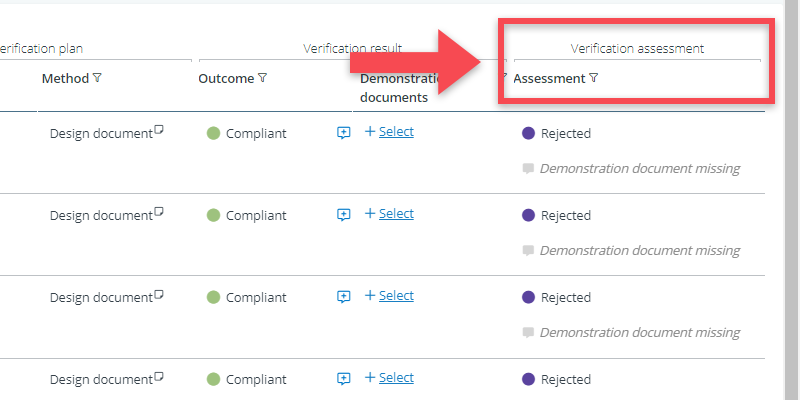
Useful actions, tips & tricks
Doing bulk actions
When you have to do a lot of repetitive data edits (e.g. making the mechanical engineering responsible for verifying all ventilation requirements) you can best use our bulk edit feature.
Read more here for how to use the bulk edit feature.

Filtering
A filter icon is located at the top of each column in the verification table. With these filters you can filter on both requirements and verification data.

Sorting
The sorting icons are located on top of each column. Click on the arrow pointing down to sort in ascending order, click on the arrow pointing up to sort in descending order.

Increasing column width
For columns that have a lot of info in them (e.g. text values), it can be useful to increase the column width. This can be done in the column header by grabbing and moving the column’s border.

Increasing the display range
The display range concerns the number of rows that are being displayed on a page. This setting is located at the bottom of the page.You can choose between 10, 25, 50 or 100 rows per page.

Dragging values
Within the verification table you are able to drag cells. If all square meters floor area, for example, need to be verified by the architect, you can select it once and then drag it down to quickly assign architect to all square meters floor area verifications, as shown below.
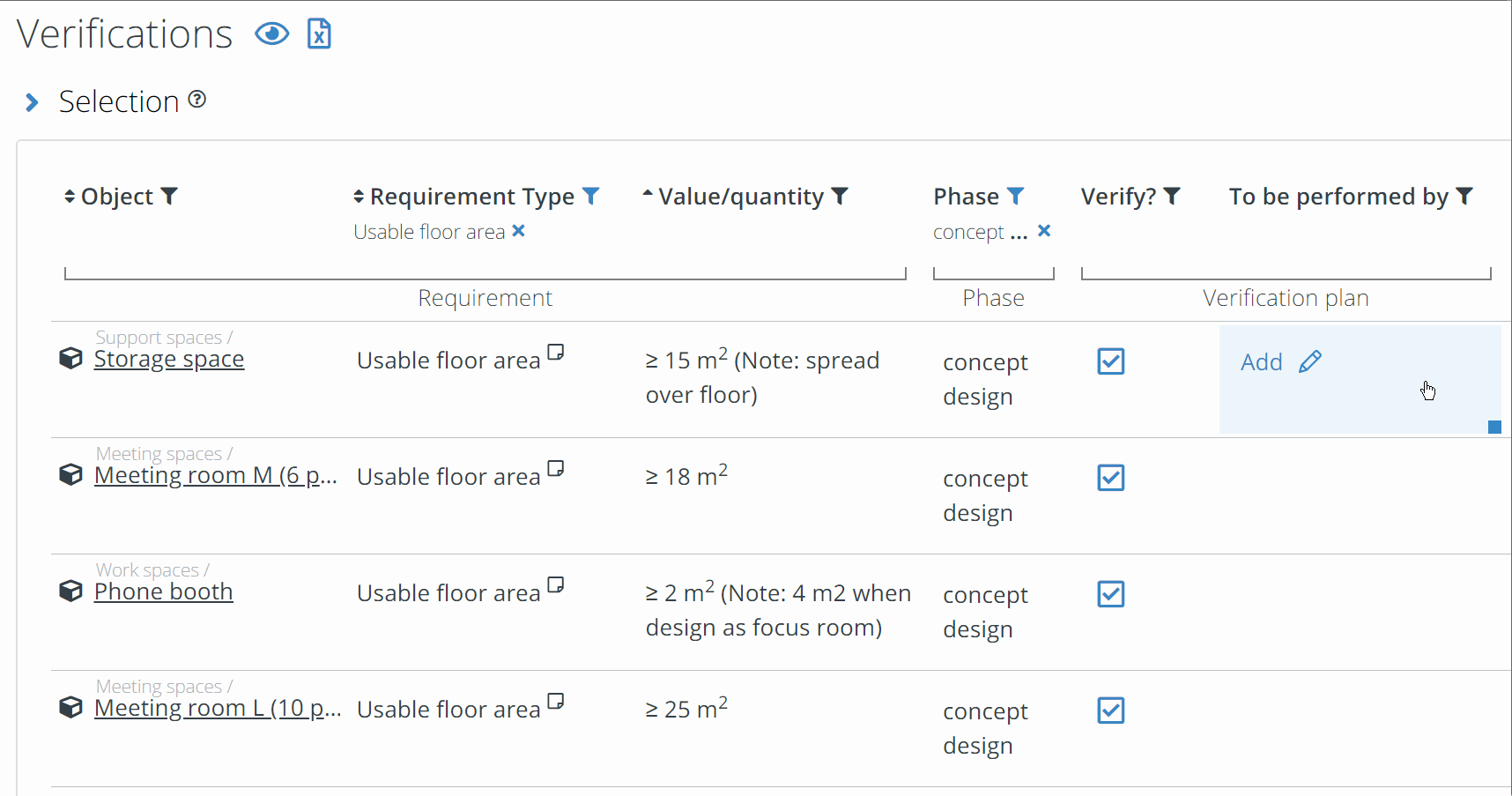
Export the table to excel
For the purpose of communication, it is sometimes easy to have data in Excel. To get an Excel export of your table, just click on the icon, right next to the overview’s name.
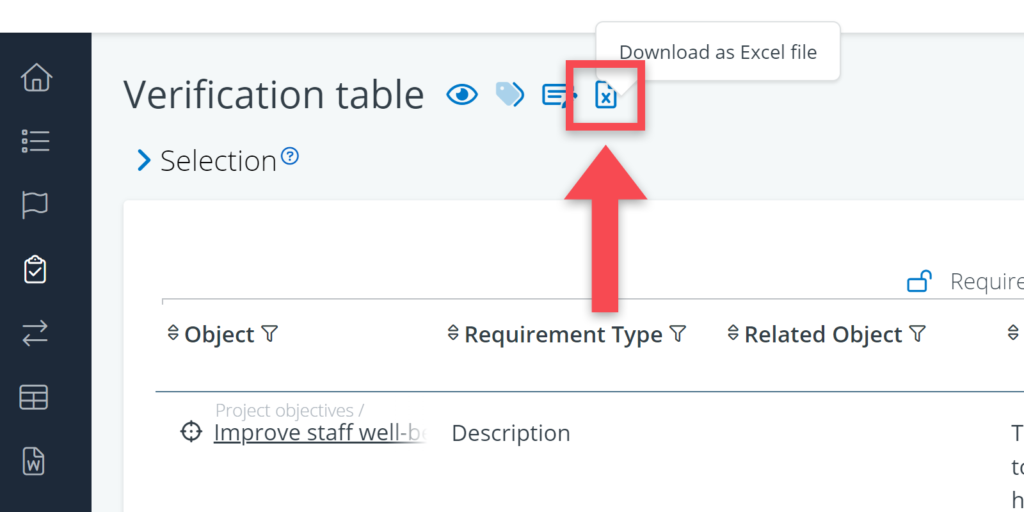
Depending on the size of the overview, it may takes some time to download the file. You can find the file in the downloads folder of your computer.
